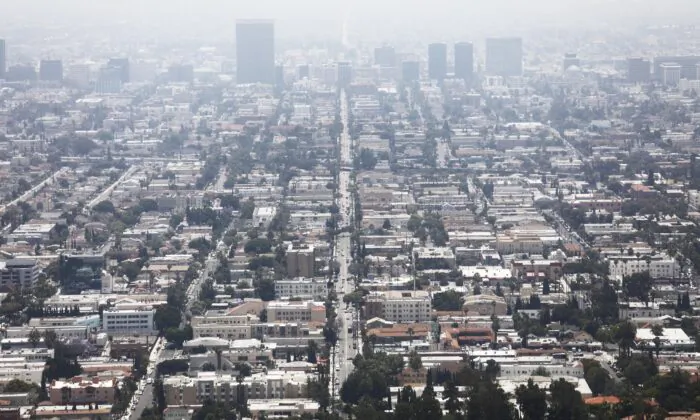Air pollution is linked to higher rates of breast cancer, a new study conducted by a cross-collaborative team of scientists at the National Institutes of Health (NIH) shows.
Researchers at the National Institute of Environmental Health Sciences (NIEHS) and National Cancer Institute (NCI) found that people living in areas with high levels of air pollution, measured as particulate matter (PM2.5), have an overall 8 percent higher incidence of breast cancer compared to people living in areas with lower levels.
There also appeared to be a relationship between PM2.5 concentration and tumor type. The study—which focused mostly on postmenopausal women—showed women living in high PM2.5 regions had a 10 percent greater incidence of estrogen receptor-positive (ER+) tumors, the most common type of breast cancer. However, there was no link between highly concentrated PM2.5 regions and estrogen receptor-negative (ER-) tumors, results published in the Journal of the National Cancer Institute on Monday showed. These findings further support a link between breast cancer and endocrine disruption, as compounds like metals and phthalates, known endocrine disrupters, attach to PM2.5.
Rates also varied depending on region. A total of eight locations were assessed, including six states (California, Florida, Pennsylvania, New Jersey, North Carolina, and Louisiana) and two metropolitan areas (Atlanta and Detroit).
Breast cancer rates were more pronounced in women who lived in catchment areas (basin-shaped areas that collect rainfall) with high levels of PM2.5, like Atlanta and North Carolina. What’s more, the researchers saw the greatest increases in breast cancer incidence among women who, on average, had higher PM2.5 levels near their homes prior to enrolling in the study compared to those who lived in areas with lower levels.
“Although this is a relatively modest increase, these findings are significant given that air pollution is a ubiquitous exposure that impacts almost everyone,” Alexander White, who has a doctorate in epidemiology and is the lead study author and head of the Environment and Cancer Epidemiology Group at NIEHS, said in a news release. “These findings add to a growing body of literature suggesting that air pollution is related to breast cancer.”
Hundreds of Different Chemicals
According to the U.S. Environmental Protection Agency (EPA), particulate matter, also called particulate pollution, is a term used to describe a mixture of tiny solid particles and liquid droplets that can be made up of hundreds of different chemicals found in the air in the form of dust, dirt, soot, or smoke.
Exposure to PM2.5 typically comes from construction sites, unpaved roads, fields, smokestacks, or fires. Other times, particulate matter is emitted as a result of complex reactions between chemicals from power plants, industries, and motor vehicle exhaust and combustion.
PM2.5 particles pose the greatest risk to health because they are small enough to be deeply inhaled and diffuse through the lungs, possibly passing into a person’s bloodstream.
Historic Exposure Increases Risk
Researchers studied nearly 200,000 women enrolled in the NIH-AARP Diet and Health Study between 1995 and 1996.
Most of the women were non-Hispanic white and averaged 62 years old. One-third had a college degree or higher, more than 50 percent of the group lived in either California (32 percent) or Florida (21 percent), and all were followed for approximately 20 years. Over the course of two decades, researchers identified 15,870 breast cancer cases.
One important aspect of the research, the authors pointed out, was that they were not just interested in participants’ geographic location upon enrollment into the NIH-AARP Diet and Health Study, but also where they lived decades before.
“Most prior studies have assessed breast cancer risk in relation to PM2.5 exposure at or around the time of study enrollment with few considering more historic exposures. This may be particularly important, as past levels of exposure were higher and may plausibly contribute to breast cancer etiology given the long latency of the disease,” the authors wrote in the paper.
To measure past exposure, researchers estimated average historical PM2.5 concentrations for each participant’s residence on an annual basis, honing in on pollution exposures during a period of 10 to 15 years prior to enrollment in the study, with residency data going back as far as 1980.
“The ability to consider historic air pollution levels is an important strength of this research,” said Rena Jones, who has a doctorate in epidemiology and is a senior author and principal investigator of the study. “It can take many years for breast cancer to develop and, in the past, air pollution levels tended to be higher, which may make previous exposure levels particularly relevant for cancer development.”
The study is one of the largest to date examining the relationship between PM2.5 and breast cancer incidence showing long-term historical exposure to PM2.5 is associated with a higher risk of ER+ breast cancer. “Future work should emphasize evaluation of historic exposure and consider region-specific associations and the potential contribution of PM2.5 chemical constituency in modifying the observed association with breast cancer,” the authors concluded.
Breast Cancer Data
Breast cancer is the most common type of cancer, with over 300,000 new cases expected in the United States in 2023, according to the NCI.
According to the American Cancer Society, there are 3.8 million breast cancer survivors in the United States. This includes women still being treated and those who have completed treatment.



